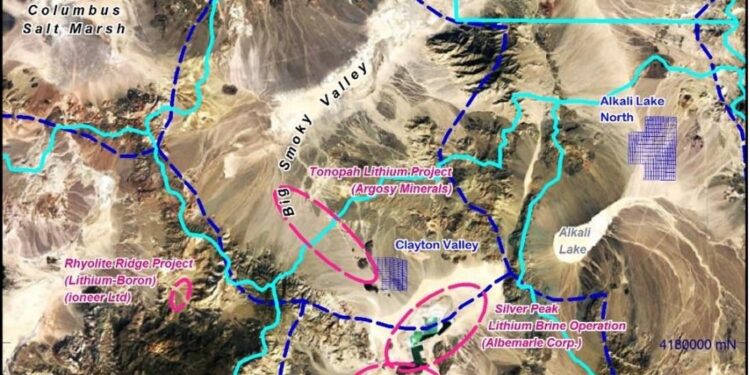A 2D shallow seismic reflection (SSR) survey has identified shallow reflectors in basinal structure at Reedy Lagoon Corporation Limited’s (ASX:RLC) Alkali Lake North Project in Nevada, USA.
Preliminary report and interpretations of the processed data have been presented to the company. The SSR was planned to gain information about the effectiveness of the SSR method at the project and, if successful, recover data that enables better characterization of the brine targets identified in Audio Magneto-telluric (AMT) data.
The survey also tests the use of the “PinPoint” source: a cost effective, environmentally friendly method (see explanation below).
The company has not yet received a final report on the work completed nor its results, however preliminary observations and interpretations include the following:
• The survey appears to have successfully imaged some reflectors located in the top 500 metres.
• Coherent and continuous reflectors are observed in the middle portion of the survey line.
• Seismic character degrades significantly in the eastern part of the traverse with reflectors appearing less coherent and discontinuous.
• Reflectors pull up towards the eastern and western ends of the line suggesting sedimentary layers sag downwards in the central portion of the project area which would be consistent with our interpreted basin structure from gravity data
The survey work was commenced on November 24 and completed on November 28, 2021. Data was collected along a single traverse measuring seven kilometres in length orientated east-west through the centre of the project area.
The seismic line was designed to gain further information about the depth to and number of aquifers indicated in the Company’s AMT survey data on its Alkali Lake North lithium brine project.
The survey also tests the use of “PinPoint” source, which is essentially a shotgun cartridge fired into the ground. The PinPoint source method has low impact on the environment and is cost efficient. The PinPoint source delivers a relatively small amount of energy into the ground.
RLC Managing Director, Geof Fethers, said for better penetration and to less ambiguously characterise deeper geology it is thought a more powerful source than PinPoint, such as a vibroseis vehicle is likely to be required.
However, for acquiring data that aids modelling brine targets at depths to about 500 metres in the Alkali Lake North project environment the PinPoint source and SSR method has demonstrated its usefulness.
“The shallow seismic survey has given RLC another dimension to its exploration targeting shallow brine aquifers. The coincidence of shallow seismic reflectors and extensive AMT conductivity anomalies located within a basin structure are strong indicators of the presence of a substantial brine aquifer system at the Alkali Lake North Project,” Mr Fethers said.
For further information please visit: https://www.reedylagoon.com.au/












